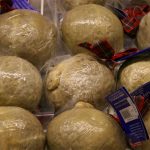 The Old French name for the magpie was agace, pronounced agg-ass and deriving from a much older word meaning pointed, as is the bird’s beak. As Rossini’s opera The Thieving Magpie attests, this noisy and quarrelsome bird is infamous for its larceny, filling its nest with stolen scraps of cloth and bits of shiny metal. The resulting hodgepodge of twigs, strings, and tin evidently reminded some medieval French wag of a well-known Scottish dish, one made by stuffing chopped liver, heart, lungs, onions, and oatmeal into a sheep’s stomach. As a result of this perceived similarity between the bird’s nest and the Scottish dish, the French began calling the dish agace, a name the English adopted in the fifteenth century after changing the spelling to haggis (the word haggis was even adopted by the Scots, who previously knew the dish by a Gaelic name, taegeis).
The Old French name for the magpie was agace, pronounced agg-ass and deriving from a much older word meaning pointed, as is the bird’s beak. As Rossini’s opera The Thieving Magpie attests, this noisy and quarrelsome bird is infamous for its larceny, filling its nest with stolen scraps of cloth and bits of shiny metal. The resulting hodgepodge of twigs, strings, and tin evidently reminded some medieval French wag of a well-known Scottish dish, one made by stuffing chopped liver, heart, lungs, onions, and oatmeal into a sheep’s stomach. As a result of this perceived similarity between the bird’s nest and the Scottish dish, the French began calling the dish agace, a name the English adopted in the fifteenth century after changing the spelling to haggis (the word haggis was even adopted by the Scots, who previously knew the dish by a Gaelic name, taegeis).
This dish is widely known and has sparked much debate over its culinary worth. It is composed of grated liver, heart, and lungs from a sheep, which are then mixed with oatmeal, suet, and various seasonings. The resulting mixture is then stuffed into the stomach of a pig or sheep and boiled to perfection.
Haggis is a traditional Scottish dish made from a combination of oatmeal, suet, and the internal organs of a sheep. The stomach of the sheep is cleaned and used as a casing for the pudding or sausage-like dish. Haggis is a beloved Scottish specialty and is often served at special occasions and events. A simpler version of haggis can be made with liver and cooked in a saucepan. Despite its unusual ingredients, haggis is a hearty and flavorful dish that is enjoyed by many people around the world.
